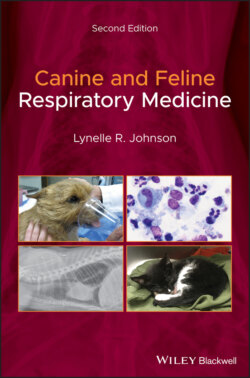Читать книгу Canine and Feline Respiratory Medicine - Lynelle Johnson R., Lynelle R. Johnson - Страница 19
Cough History
ОглавлениеCough occurs because of activation of irritant receptors that lie between epithelial cells lining the airways and can be triggered by inflammatory products of neutrophils or eosinophils, by the presence of excess secretions, and by airway compression or collapse (Table 1.2). Important historical features to determine include the onset and duration of cough, the character of the cough, and environmental features that appear to trigger cough.
The character of the cough described by the owner is occasionally helpful when prioritizing differential diagnoses, although substantial overlap exists among the causes of cough. Animals with a wet‐ or moist‐sounding cough can have excessive airway secretions due to infectious or inflammatory airway disease or as a result of parenchymal disease. Observant owners of the animal with a productive cough may note that the animal swallows after coughing or retches to remove secretions from the airway. However, diseases of the airway can also result in a dry cough when secretions are minimal or early in the course of disease. Cough in animals with airway disease is often harsh and can be chronic, intermittent, or paroxysmal in nature. Infectious respiratory disease in young puppies typically results in a hoarse, seal‐bark cough and this is often ascribed to bordetellosis. A honking cough is frequently described in dogs with tracheal or airway collapse and a brisk snapping sound on expiration is suggestive of large airway collapse. Animals with pneumonia might have a softer cough along with a vague history of illness characterized by anorexia and lethargy. Dogs with heart disease also can have a soft cough associated with tachypnea, exercise intolerance, or lethargy. With severe or fulminant pulmonary edema, a dog might expectorate pink foam if pulmonary edema has flooded the alveolar space and entered the airways. However, the common association of cough with congestive heart failure has been called into question (Ferasin et al. 2013).
Table 1.2 Respiratory causes of cough in dogs and cats.
| Dog | Cat | |
| Infectious tracheobronchitis | Canine infectious respiratory disease complexa | Mycoplasma Bordetella |
| Pneumonia | Bacterial Aspiration Foreign body Fungal Interstitialb | Bacterial Aspiration Foreign body Fungalb Interstitialb |
| Inflammatory disease | Chronic bronchitis Eosinophilic bronchopneumopathy | Asthma/chronic bronchitis |
| Neoplasia | Primary Metastatic | Primary Metastatic |
| Structural disorders | Bronchiectasis Airway collapse | Bronchiectasis |
a Reported causes include canine adenovirus‐2, canine parainfluenza‐3 virus, canine respiratory coronavirus, canine herpesvirus, influenza viruses, and canine distemper virus along with Bordetella, Mycoplasma, and Streptococcus equi subsp. zooepidemicus.
b More commonly a cause of tachypnea than cough.
Determining environmental and travel history is important for animals with cough. Exposure to a high‐density dog population should raise concern for disease associated with canine infectious respiratory disease complex. If the cough is harsh and dry, Bordetella should be considered, while a soft, chronic cough could be suggestive of canine influenza virus infection. Sporting dogs that develop an acute onset of cough or have a chronic, antibiotic‐responsive cough could have foreign body pneumonia. Fungal pneumonia should be suspected in animals with cough that have traveled to endemic regions. In those animals, cough is usually accompanied by tachypnea and systemic signs of illness. Finally, environmental history is important, because exposure to pollutants and airway irritants can exacerbate upper or lower airway diseases in both dogs and cats, although it remains unclear whether or not exposure to second‐hand smoke is an important factor in worsening cough in animals (Hawkins et al. 2010).
